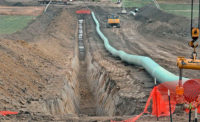
A federal judge in rural Michigan refused to decide a case in favor of a subcontractor based on testimony that the project manager who signed an indemnification was sleep deprived.
The decision, filed in August, upheld the validity of a the signature on a backdated agreement that indemnifies the designers of a temporary dewatering structure that failed and caused an earthen dam breach along the Boardman River in October 2012.
Subcontractor Molon Excavating Inc. argued before a federal judge in Grand Traverse County, Mich., that the firm’s project manager was not in the right condition to understand what he was signing, and that the engineering firm Schiffer Group Inc. told the project manager that the agreement would protect both companies.
Judge Philip Rodgers decided that the agreement was valid because the project manager was given an opportunity to read the agreement, and that sleep deprivation is not enough of an impairment to negate the signature.
The dewatering structure was put in place during a dam removal project and the failure of both inflicted $445,000 of damge on 36 homes, according to an estimate by AMEC Environment & Infrastructure, a principal contractor on the project. The homeowners have made claims against AMEC, Molon and Schiffer Group.
The decision clears the way for homeowner claims against companies involved but leaves standing Molon's indemnification of Schiffer Group.
According to the Michigan Dept.of Environmental Quality report on the 2012 dam breach, the dewatering structured failed during testing when water was allowed to contact the stoplog weir at its entrance. Ten minutes after water came in contact with the weir, water boiled up adjacent to the dewatering structure wall, downstream of its concrete control section.
The boil grew and scoured the dam embankments, which resulted in the complete failure of the embankment section between the dewatering structure and the dam spillway. Analysis found that the most likely cause of the dewatering structure’s failure was internal erosion of foundation material underneath the control section.
Background on the Dam
The Brown Bridge Dam was built on the Boardman River in 1921 as a 1,600-foot earth embankment with powerhouse and spillway structure for hydroelectricity generation. It impounded the river into a pond of 190 acres. Traverse City Light and Power decommissioned the dam, and all other hydroelectric dams along the river, in 2005 due to economic considerations. Regional and federal government bodies recommended in 2008 that the dams, owned by Traverse City, be removed to return the river to a free-flowing state.
Because the existing structure could not fully drain the impoundment, AMEC proposed a water control structure that required subsurface drilling and sampling. Molon, as subcontractor, proposed a dewatering structure that required neither, which AMEC approved. Molon hired the Schiffer GroupI to design the dewatering structure. The design called for steel sheetpile sidewalls, two timber stoplog bays and a concrete control section with a riprap-lined channel downstream.
In later motions, AMEC would claim that Schiffer group breached profession duty of care for several reasons. Among them were the lack of an upstream apron with upstream seepage cutoff, a downstream apron with or without scour cutoff on the downstream end and filters and drains under the apron. But the court rejected the claim.
The dewatering structure was designed to gradually lower the level of water in the impoundment over 20 days, but due to the incident, 14 feet of water flooded downstream from the already partially drained 170-acre impoundment within six hours.
The August 15 decision states that while the project manager “believed the Professional Services Agreement would provide insurance coverage for both SGI and Molon based on his communication with SGI [and] signed the Agreement because he thought it would help Molon, however, one who signs a contract cannot argue, when enforcement is sought, that he did not read the contract, or that he supposed it was different in terms.” Even though the court found that [the project manager] was seriously sleep deprived, the decision states that his condition was not impaired enough to invalidate his signature.
Backdated Signature
The project manager signed the agreement after the dam breach accident, but according to the court decision, he backdated the signature to June 2012.
The Brown Bridge Dam was removed and the 2.5-mile river channel through the floodplain was restored as of September 2013.
Legal representatives of Schiffer Group and Traverse City did not respond to requests for comment. Representatives of Molon and AMEC declined to comment for this article since the court case is in progress.



Post a comment to this article
Report Abusive Comment